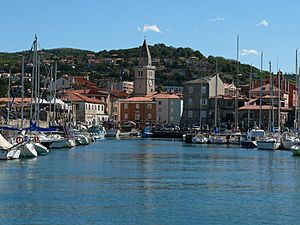Istrian Italians facts for kids
Istrian Italians are one of the main groups of people living in Istria. Istria is a large peninsula in the Adriatic Sea. Other groups living there include Croatians, Slovenians, and Istrorumanians.
Contents
A Look Back: History of Istrian Italians
The Istrian Italians are descendants of people who lived in Istria during the Roman Empire. These people adopted Roman ways and language. For many centuries, different rulers controlled Istria. These included the Byzantine Empire and the Holy Roman Empire.
However, for a long time, especially during the Renaissance, Istria was part of the Republic of Venice. Under Venetian rule, Istrian Italians saw a lot of cultural growth. Cities like Pola and Capodistria became important centers for art and learning. Famous people from this time include Pier Paolo Vergerio, a well-known scholar, and Santorius Santorio, a doctor who invented the medical thermometer.
In the last 200 years, the number of Istrian Italians has changed a lot. At one point, during the time of Napoleon, they were the largest group in Istria. But over time, there were disagreements and tensions with Slavic groups in Istria. This led to many changes. After WWII, many Istrian Italians left their homes. This big movement of people is known as the Istrian exodus. Some also faced very difficult times, like the Foibe massacres. Because of these events, Istrian Italians became a much smaller group in the region.
Where Istrian Italians Live Today
A census from 1936 showed that most of the 294,000 people in Istria were Istrian Italians. Here's a quick look at the percentages in different areas back then:
| Area | Italians | Slovenians | Croatians |
| Pola | 68% | - | 32% |
| Pisino (Province of Pola) | 28% | 2% | 70% |
| Capodistria (Province of Pola) | 50% | 35% | 15% |
| Lussino (Province of Pola) | 57% | - | 43% |
| Parenzo (Province of Pola) | 72% | 4% | 24% |
| Fiume | 81% | 3% | 16% |
| Abbazia (Province of Fiume) | 24% | 30% | 46% |
Today, there are about 50,000 Istrian Italians. They are a small part of the total population in the Istria peninsula. Most of them live in Croatia and Slovenia. However, a few thousand still live in Italy, especially in the coastal town of Muggia near Trieste.
In some towns in modern-day Croatia and Slovenia, many Italians still live there. For example, in Grožnjan/Grisignana, 51% of the people are Italian. In Brtonigla/Verteneglio, it's 37%, and in Buje/Buie, nearly 30% are Italian.
Related pages
- Benussi, Bernardo. L'Istria nei suoi due millenni di storia. Treves-Zanichelli. Trieste 1924.
Images for kids











